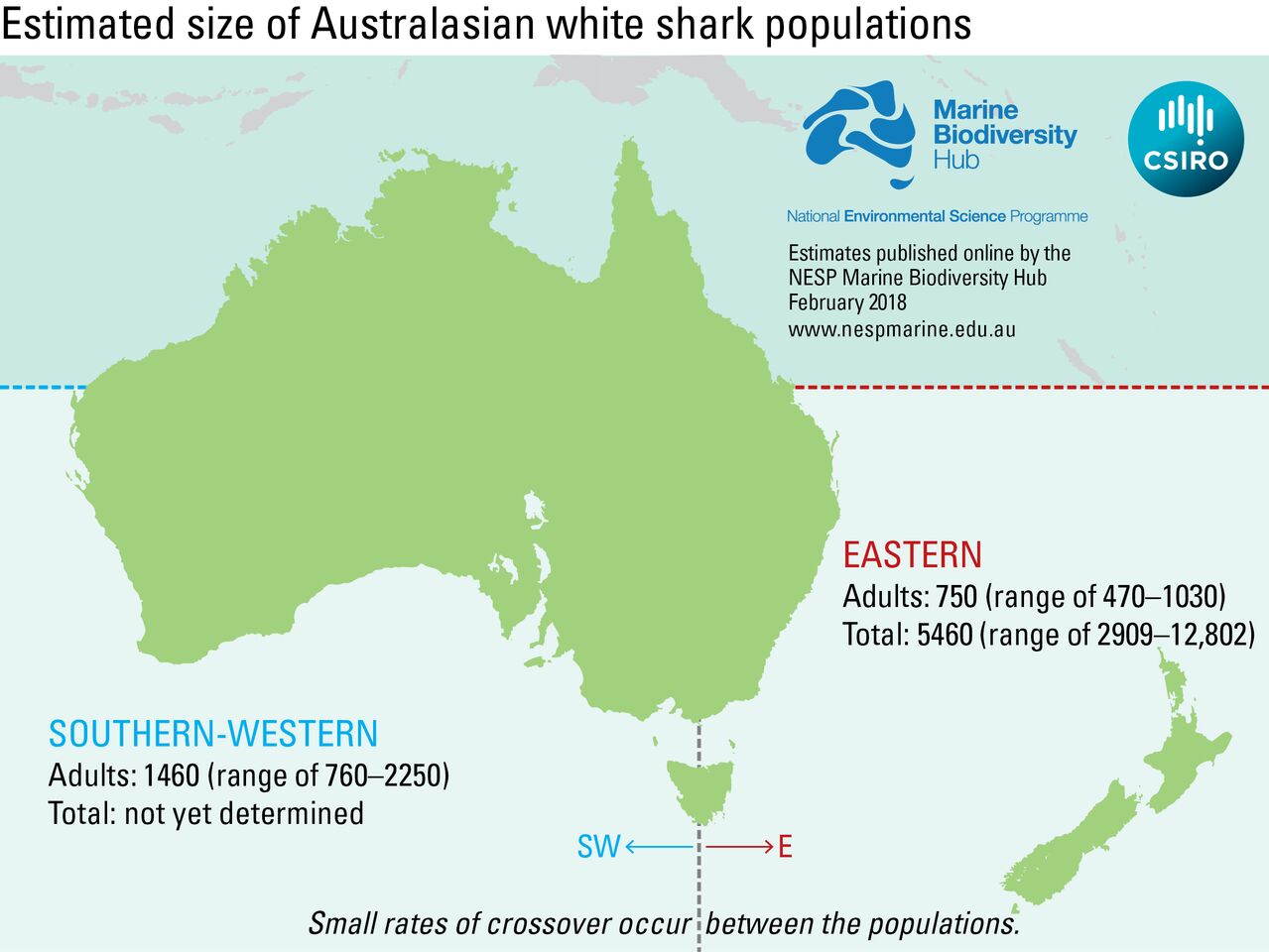Australia has two white shark populations, an eastern population ranging east of Wilson's Promontory, Victoria, to at least central Queensland and across to New Zealand, and a southern-western population ranging west of Wilson’s Promontory to north-western Western Australia.
The local abundance of white sharks in shelf and coastal waters varies from season to season and year to year due to variations in shark distribution and movement patterns. In some coastal areas, people will see more sharks than average; in other years, fewer than average sharks will be seen. These variations are due to changes in distribution that are likely to be in response to environmental factors and prey movements and abundance.
Breakthrough research to estimate numbers
The CSIRO has developed a world-first genetic analysis technique to estimate adult white shark numbers for both the eastern Australasian and southern-western white shark populations, all without having to catch or even see any adult white sharks. Instead, they locate the tell-tale marks of the parents in the DNA collected from juveniles, a method known as close-kin mark-recapture.
Close-kin mark-recapture first involves taking a tissue sample from a shark and obtaining a genetic profile of that animal; this is then compared to all of the other sampled sharks’ DNA profiles to determine if the shark is related, and how. This highly detailed genetic data sampling is then combined with a breakthrough statistical method to estimate adult white shark numbers.
Extensive acoustic and satellite tagging of juveniles at two identified nurseries on the Australian east coast provided the scientific evidence to estimate juvenile survival for the eastern population – an essential component to estimating total population size. An estimate of the juvenile survival rate for the southern-western population is not yet known and requires an expanded tagging effort and associated data collection.
Population estimates
CSIRO research reveals that there are about 750 adults in the eastern Australasian white shark population (with a range from 470 to 1030), with a total eastern population of 5460 (with a potential range between 2909 and 12,802). For the southern-western population, the estimate is 1460 adult white sharks (with a range of 760 to 2250).
Australia has two white shark populations, an eastern population ranging east of Wilson's Promontory, Victoria, to at least central Queensland and across to New Zealand, and a southern-western population ranging west of Wilson’s Promontory to north-western Western Australia.
The local abundance of white sharks in shelf and coastal waters varies from season to season and year to year due to variations in shark distribution and movement patterns. In some coastal areas, people will see more sharks than average; in other years, fewer than average sharks will be seen. These variations are due to changes in distribution that are likely to be in response to environmental factors and prey movements and abundance.
Breakthrough research to estimate numbers
The CSIRO has developed a world-first genetic analysis technique to estimate adult white shark numbers for both the eastern Australasian and southern-western white shark populations, all without having to catch or even see any adult white sharks. Instead, they locate the tell-tale marks of the parents in the DNA collected from juveniles, a method known as close-kin mark-recapture.
Close-kin mark-recapture first involves taking a tissue sample from a shark and obtaining a genetic profile of that animal; this is then compared to all of the other sampled sharks’ DNA profiles to determine if the shark is related, and how. This highly detailed genetic data sampling is then combined with a breakthrough statistical method to estimate adult white shark numbers.
Extensive acoustic and satellite tagging of juveniles at two identified nurseries on the Australian east coast provided the scientific evidence to estimate juvenile survival for the eastern population – an essential component to estimating total population size. An estimate of the juvenile survival rate for the southern-western population is not yet known and requires an expanded tagging effort and associated data collection.
Population estimates
CSIRO research reveals that there are about 750 adults in the eastern Australasian white shark population (with a range from 470 to 1030), with a total eastern population of 5460 (with a potential range between 2909 and 12,802). For the southern-western population, the estimate is 1460 adult white sharks (with a range of 760 to 2250).
Estimated size of adult white shark populations 750 adults in the eastern Australasian white shark population (with a range from 470 to 1030), with a total eastern population of 5460 (with a potential range between 2909 and 12,802). For the southern-western population, the estimate is 1460 adult white sharks (with a range of 760 to 2250).
